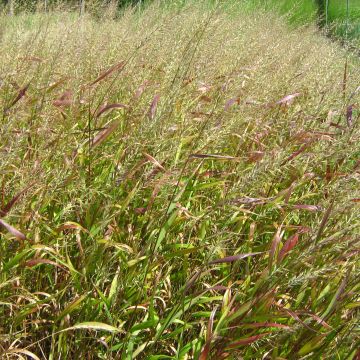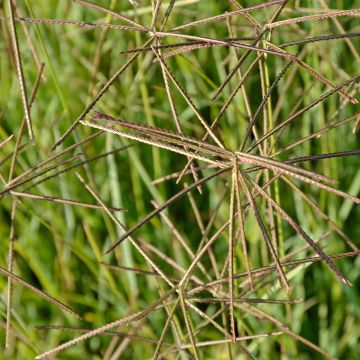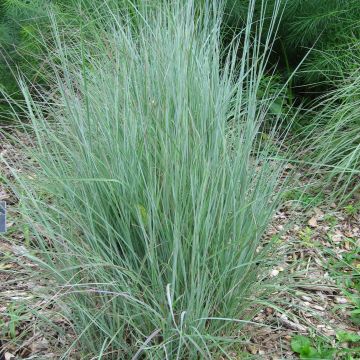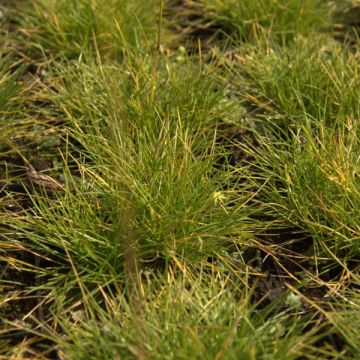

Pennisetum setaceum Skyrocket
Pennisetum setaceum Skyrocket
Pennisetum x advena Skyrocket
Fountain Grass
This item cannot be shipped to the selected country
Delivery charge from €5.90
More information
Schedule delivery date,
and select date in basket
This plant carries a 6 months recovery warranty
More information
We guarantee the quality of our plants for a full growing cycle, and will replace at our expense any plant that fails to recover under normal climatic and planting conditions.
From €5.90 for pickup delivery and €6.90 for home delivery
Express home delivery from €8.90.
Does this plant fit my garden?
Set up your Plantfit profile →
Description
IMPORTANT : for the preservation of our natural ecosystems and in accordance with European Regulation No. 1143/2014 on the prevention and management of the introduction and spread of invasive alien species, we have removed this plant from our catalogue. It is therefore no longer available for sale.
The Pennisetum setaceum 'Skyrocket', a variegated form of Fountain Grass, is a perennial, frost-sensitive grass that is often grown as an annual in our climate. Its light green foliage is striated or edged with white-cream throughout its length, further enhancing the delicacy of its striped leaves and its overall brightness. From mid-summer to autumn, soft and pale pinkish-brown bearded spikes emerge from an infinitely graceful fountain of foliage. Their colour gradually takes on shades of pale gold and silver, a welcome addition to autumn bouquets. An essential and versatile plant, magnificently coloured, it brings an exotic and elegant feel to flower beds, and is a favourite in flower pots, whether modern or romantic in style or in more natural arrangements.
Pennisetum setaceum is a rhizomatous perennial plant native to tropical Africa that cannot tolerate temperatures below -8°C, but with rapid growth, it can be grown as an annual. The 'Skyrocket' cultivar, a sport of the 'Fireworks' variety, belongs to a series of ornamental grasses called Graceful Grasses. It was selected in March 2009 by the American firm Proven Winners. The plant forms a fountain of rough, striped foliage, reaching a height of 80 cm (31.5 in) when in bloom and a width of 50 cm (19.7 in), with a variegated colour of bright green and creamy white. The flowering period is from July to October, longer if the autumn is mild. The arching spikes carried on stiff stems droop gracefully above the foliage. They are composed of tiny white to pinkish-brown spikelets, arranged in narrow panicles, 20 to 30 cm (11.8 in) long, covered in long hairs and with a feathery appearance. As they fade, they take on a lighter, almost silvery hue.
Pennisetum setaceum is the most well-known of the pennisetums, and it continues to be popular among professional and amateur gardeners alike. It is versatile, both in its exotic and elegant appearance, easy to grow, and very undemanding. Perfectly adapted to sea spray and drought, it is useful in dry gardens, as well as in flower pots or rockeries. Plant it en masse along pathways, or create very romantic displays with autumn-flowering perennials such as asters, hardy chrysanthemums, and Japanese anemones. It is also a good ground cover in mild climates.
Report an error about the product description
Pennisetum setaceum Skyrocket in pictures


Flowering
Foliage
Plant habit
Botanical data
Pennisetum
x advena
Skyrocket
Poaceae
Fountain Grass
Cultivar or hybrid
Other Pennisetum
Planting and care
Plant your Pennisetum setaceum in a sunny position or possibly in partial shade. They require a light and well-drained soil, even poor or chalky soil. They tolerate dry soils once established. You can plant your Pennisetum in a pot which will need more regular watering. Usually grown as annuals, they are actually delicate perennials: by bringing them indoors at the first frost, you can extend their flowering period during autumn and winter. Outdoor cultivation is possible by the seaside, with a good mulching in winter. Prune lightly in March, or let the frost decorate their wonderful crowned fountains of faded inflorescences.
Planting period
Intended location
Care
This item has not been reviewed yet - be the first to leave a review about it.
Ornamental grasses
Haven't found what you were looking for?
Hardiness is the lowest winter temperature a plant can endure without suffering serious damage or even dying. However, hardiness is affected by location (a sheltered area, such as a patio), protection (winter cover) and soil type (hardiness is improved by well-drained soil).

Photo Sharing Terms & Conditions
In order to encourage gardeners to interact and share their experiences, Promesse de fleurs offers various media enabling content to be uploaded onto its Site - in particular via the ‘Photo sharing’ module.
The User agrees to refrain from:
- Posting any content that is illegal, prejudicial, insulting, racist, inciteful to hatred, revisionist, contrary to public decency, that infringes on privacy or on the privacy rights of third parties, in particular the publicity rights of persons and goods, intellectual property rights, or the right to privacy.
- Submitting content on behalf of a third party;
- Impersonate the identity of a third party and/or publish any personal information about a third party;
In general, the User undertakes to refrain from any unethical behaviour.
All Content (in particular text, comments, files, images, photos, videos, creative works, etc.), which may be subject to property or intellectual property rights, image or other private rights, shall remain the property of the User, subject to the limited rights granted by the terms of the licence granted by Promesse de fleurs as stated below. Users are at liberty to publish or not to publish such Content on the Site, notably via the ‘Photo Sharing’ facility, and accept that this Content shall be made public and freely accessible, notably on the Internet.
Users further acknowledge, undertake to have ,and guarantee that they hold all necessary rights and permissions to publish such material on the Site, in particular with regard to the legislation in force pertaining to any privacy, property, intellectual property, image, or contractual rights, or rights of any other nature. By publishing such Content on the Site, Users acknowledge accepting full liability as publishers of the Content within the meaning of the law, and grant Promesse de fleurs, free of charge, an inclusive, worldwide licence for the said Content for the entire duration of its publication, including all reproduction, representation, up/downloading, displaying, performing, transmission, and storage rights.
Users also grant permission for their name to be linked to the Content and accept that this link may not always be made available.
By engaging in posting material, Users consent to their Content becoming automatically accessible on the Internet, in particular on other sites and/or blogs and/or web pages of the Promesse de fleurs site, including in particular social pages and the Promesse de fleurs catalogue.
Users may secure the removal of entrusted content free of charge by issuing a simple request via our contact form.
The flowering period indicated on our website applies to countries and regions located in USDA zone 8 (France, the United Kingdom, Ireland, the Netherlands, etc.)
It will vary according to where you live:
- In zones 9 to 10 (Italy, Spain, Greece, etc.), flowering will occur about 2 to 4 weeks earlier.
- In zones 6 to 7 (Germany, Poland, Slovenia, and lower mountainous regions), flowering will be delayed by 2 to 3 weeks.
- In zone 5 (Central Europe, Scandinavia), blooming will be delayed by 3 to 5 weeks.
In temperate climates, pruning of spring-flowering shrubs (forsythia, spireas, etc.) should be done just after flowering.
Pruning of summer-flowering shrubs (Indian Lilac, Perovskia, etc.) can be done in winter or spring.
In cold regions as well as with frost-sensitive plants, avoid pruning too early when severe frosts may still occur.
The planting period indicated on our website applies to countries and regions located in USDA zone 8 (France, United Kingdom, Ireland, Netherlands).
It will vary according to where you live:
- In Mediterranean zones (Marseille, Madrid, Milan, etc.), autumn and winter are the best planting periods.
- In continental zones (Strasbourg, Munich, Vienna, etc.), delay planting by 2 to 3 weeks in spring and bring it forward by 2 to 4 weeks in autumn.
- In mountainous regions (the Alps, Pyrenees, Carpathians, etc.), it is best to plant in late spring (May-June) or late summer (August-September).
The harvesting period indicated on our website applies to countries and regions in USDA zone 8 (France, England, Ireland, the Netherlands).
In colder areas (Scandinavia, Poland, Austria...) fruit and vegetable harvests are likely to be delayed by 3-4 weeks.
In warmer areas (Italy, Spain, Greece, etc.), harvesting will probably take place earlier, depending on weather conditions.
The sowing periods indicated on our website apply to countries and regions within USDA Zone 8 (France, UK, Ireland, Netherlands).
In colder areas (Scandinavia, Poland, Austria...), delay any outdoor sowing by 3-4 weeks, or sow under glass.
In warmer climes (Italy, Spain, Greece, etc.), bring outdoor sowing forward by a few weeks.
























































